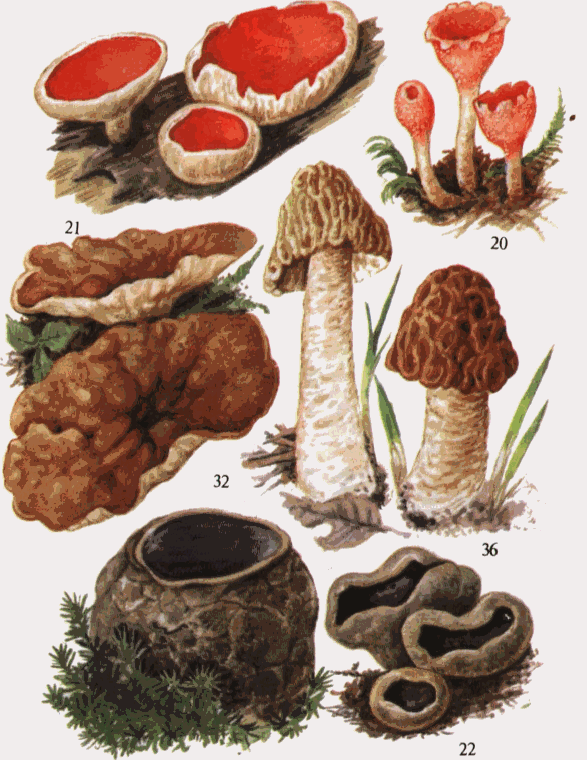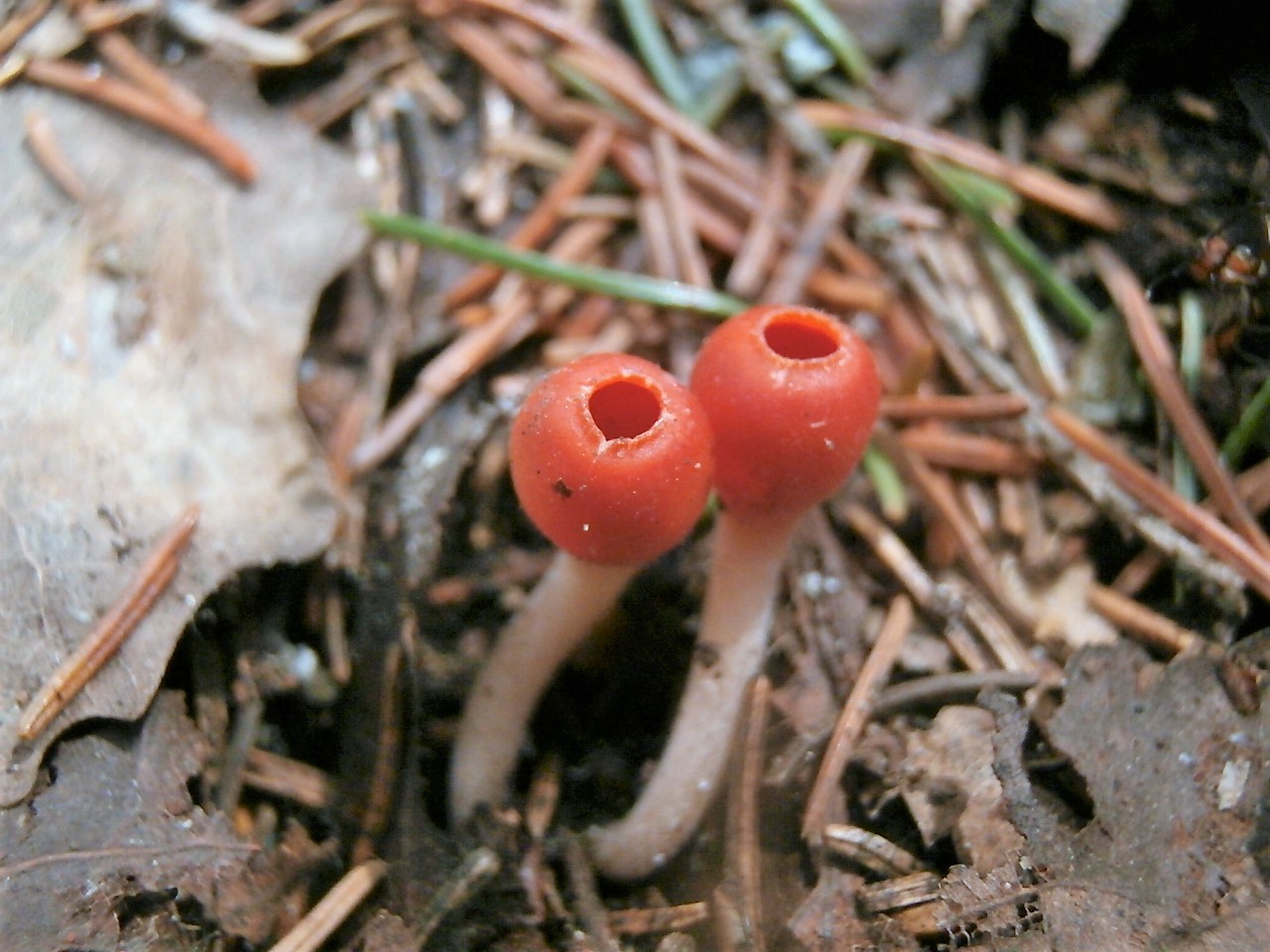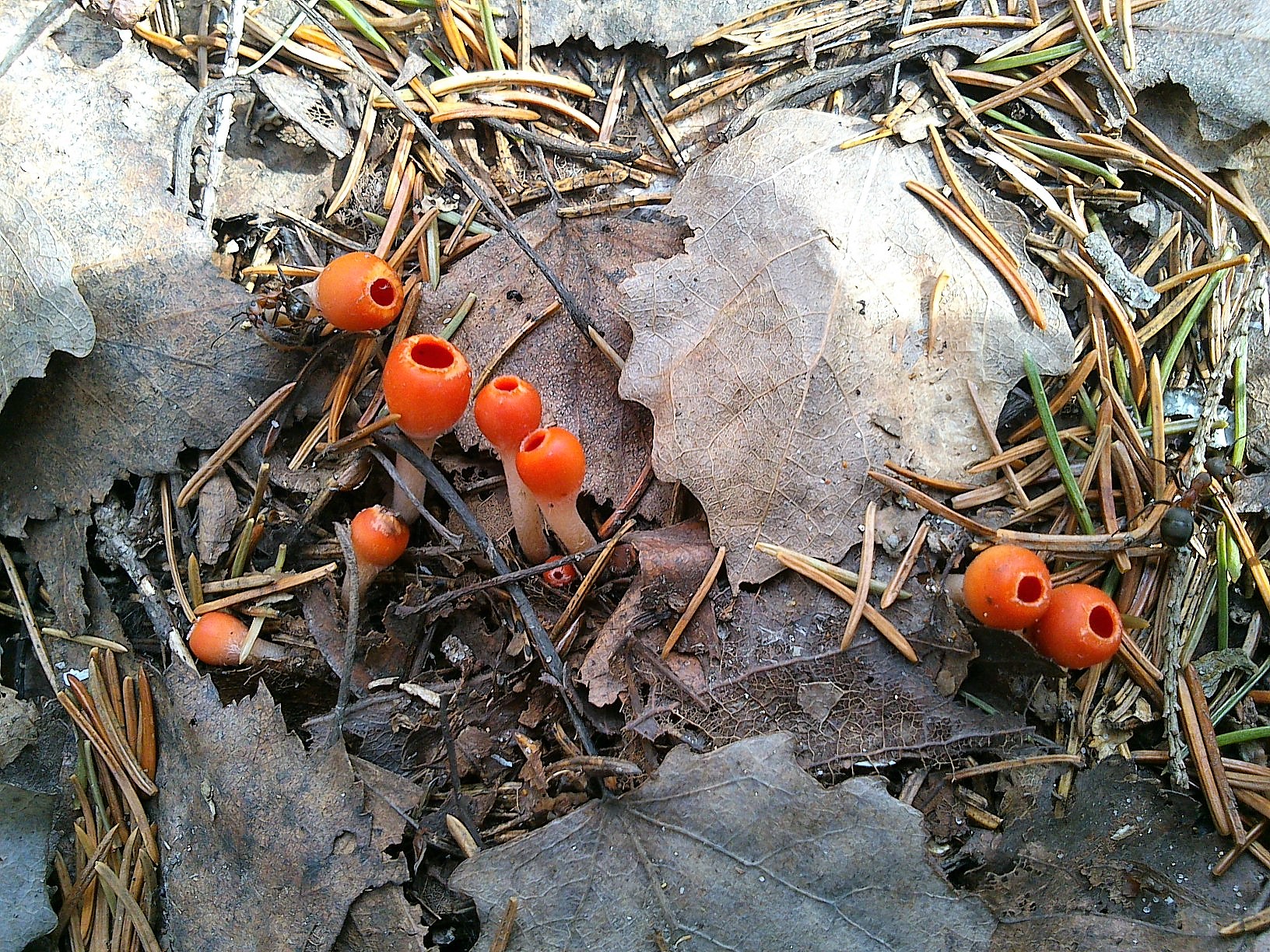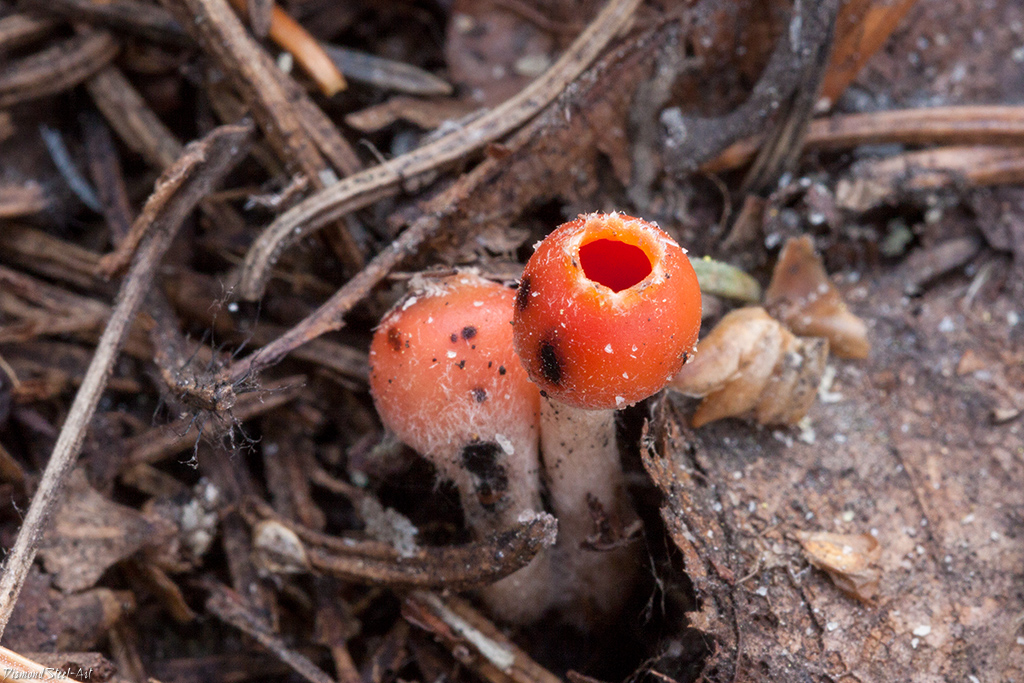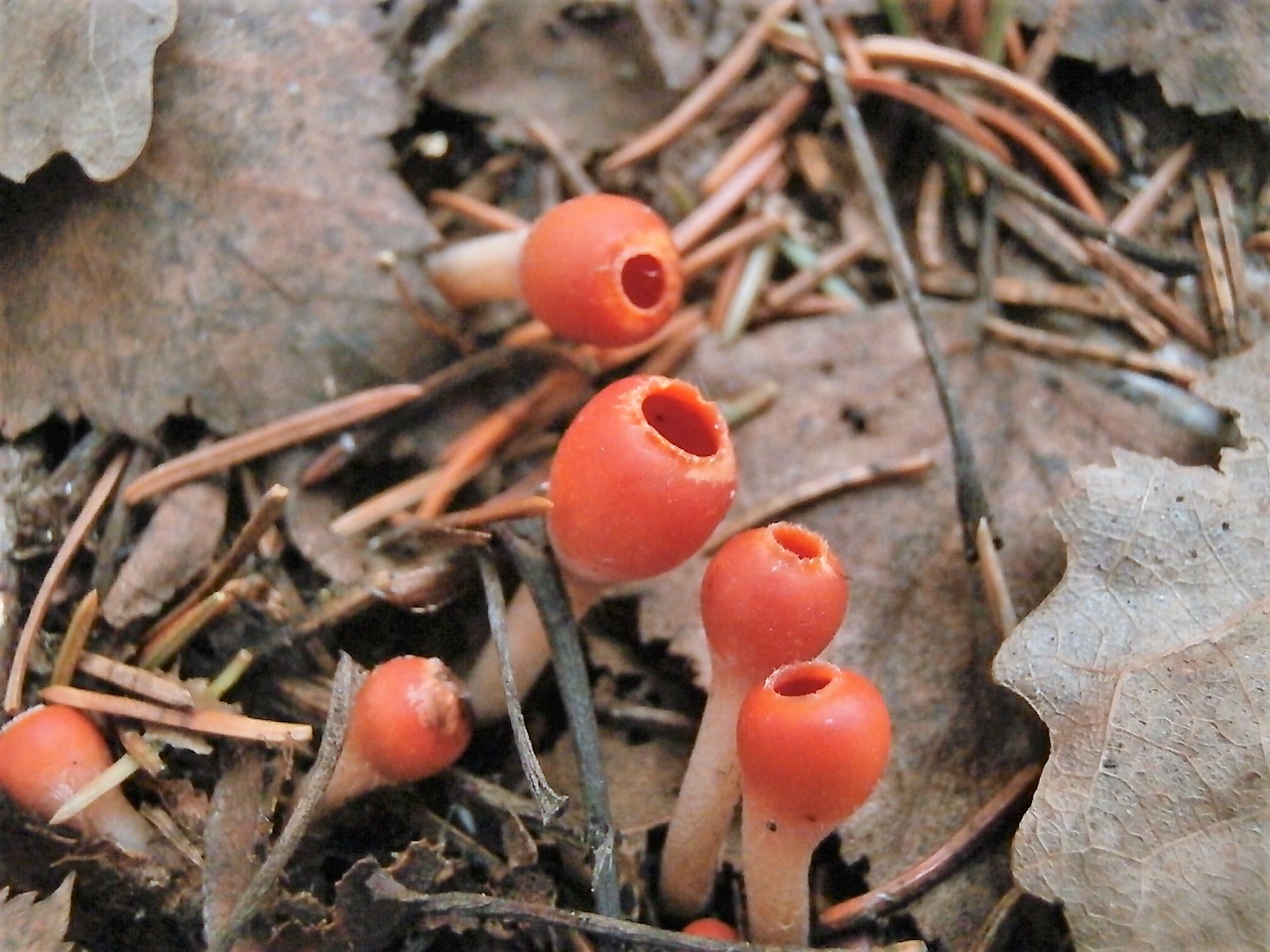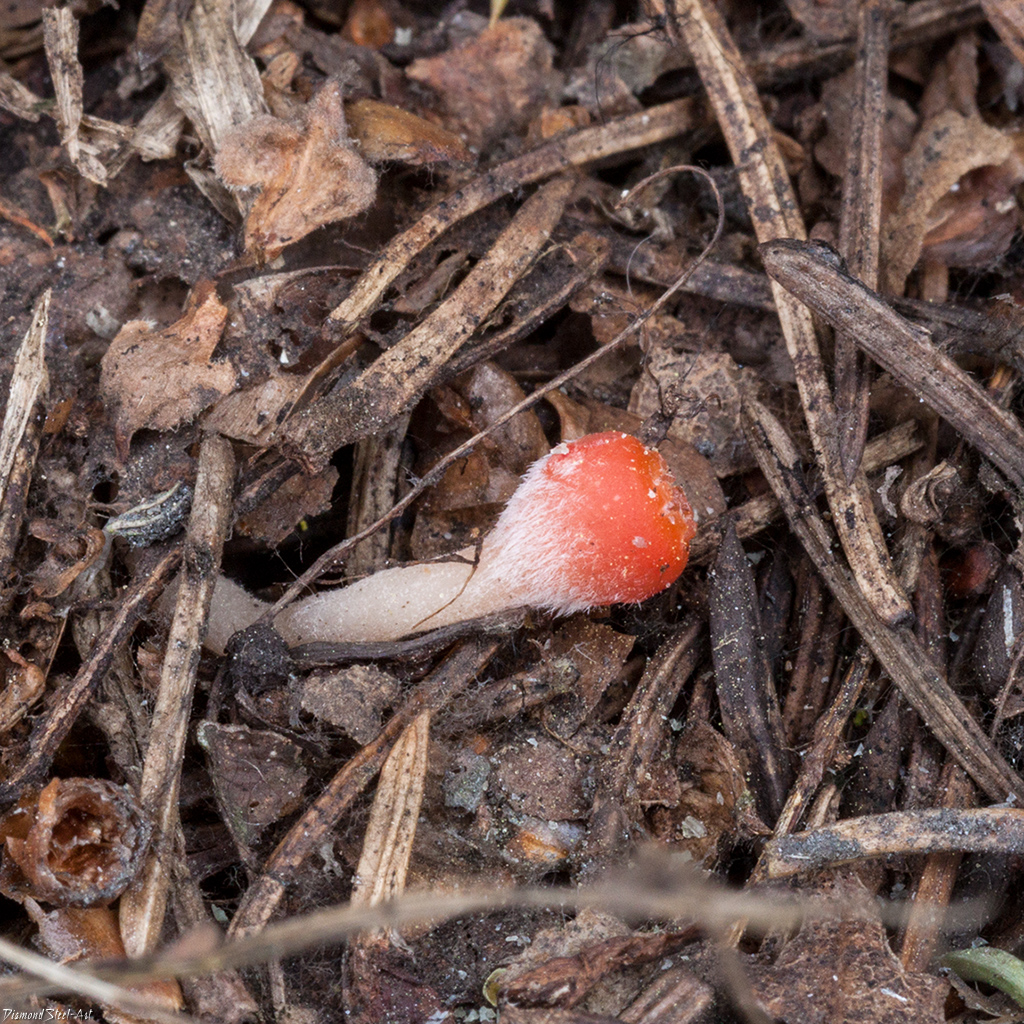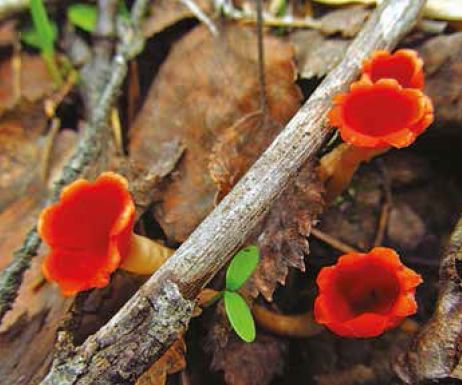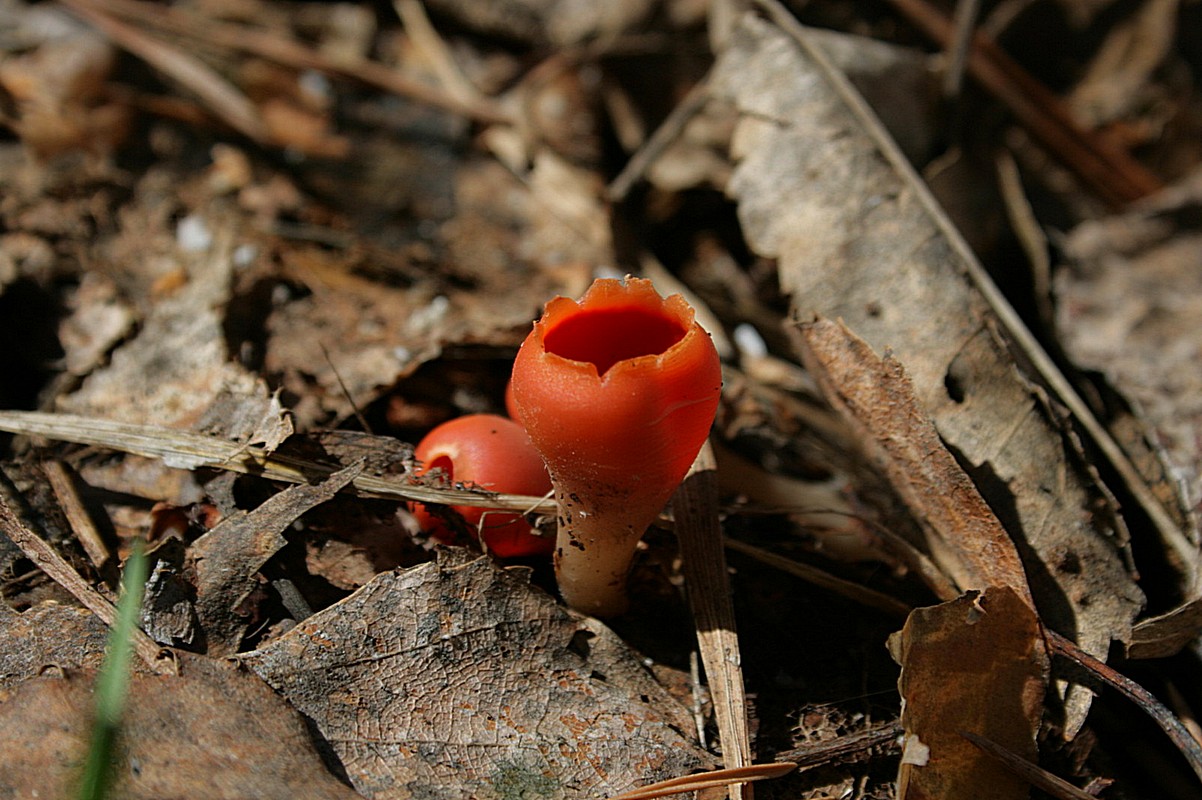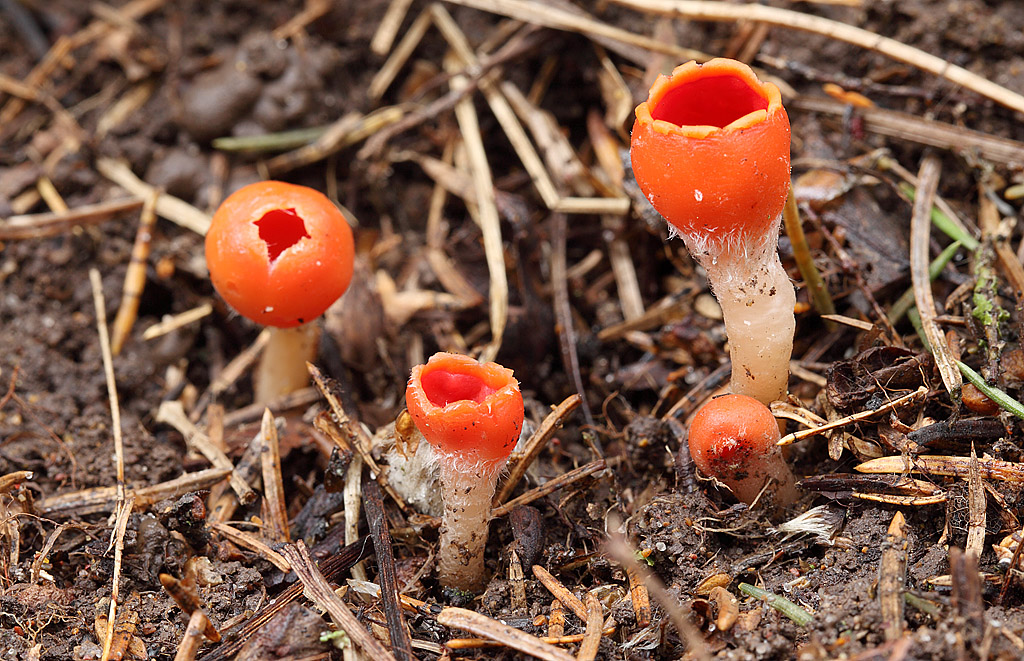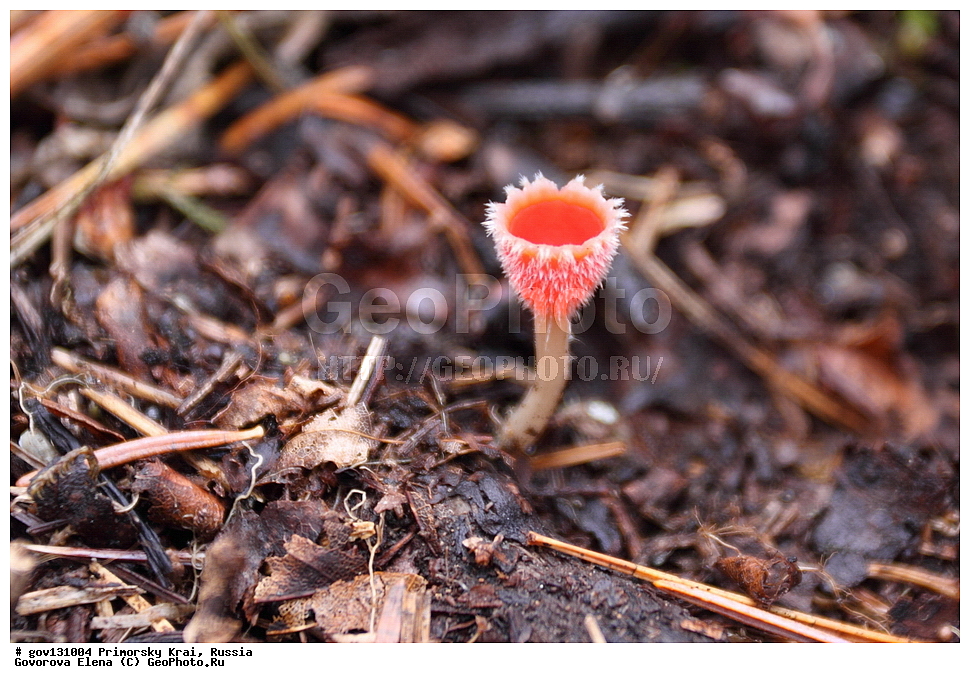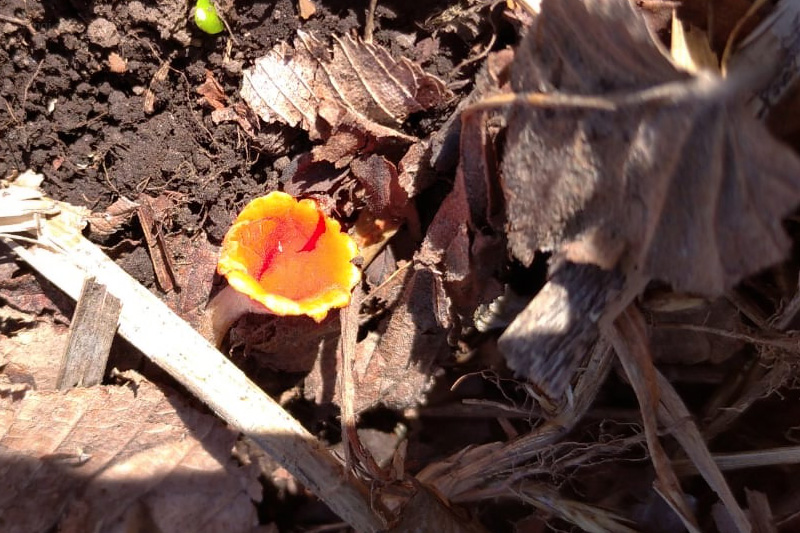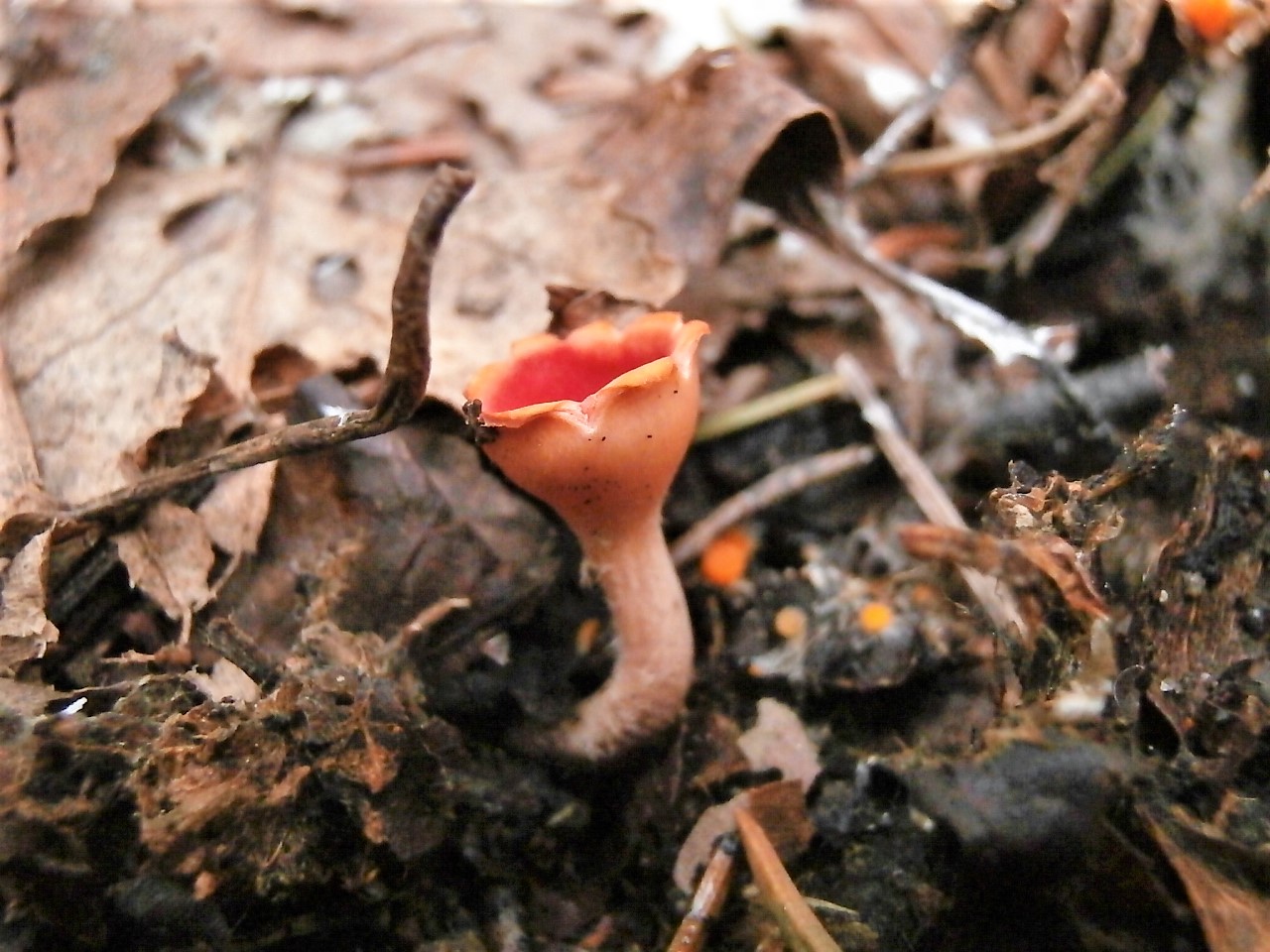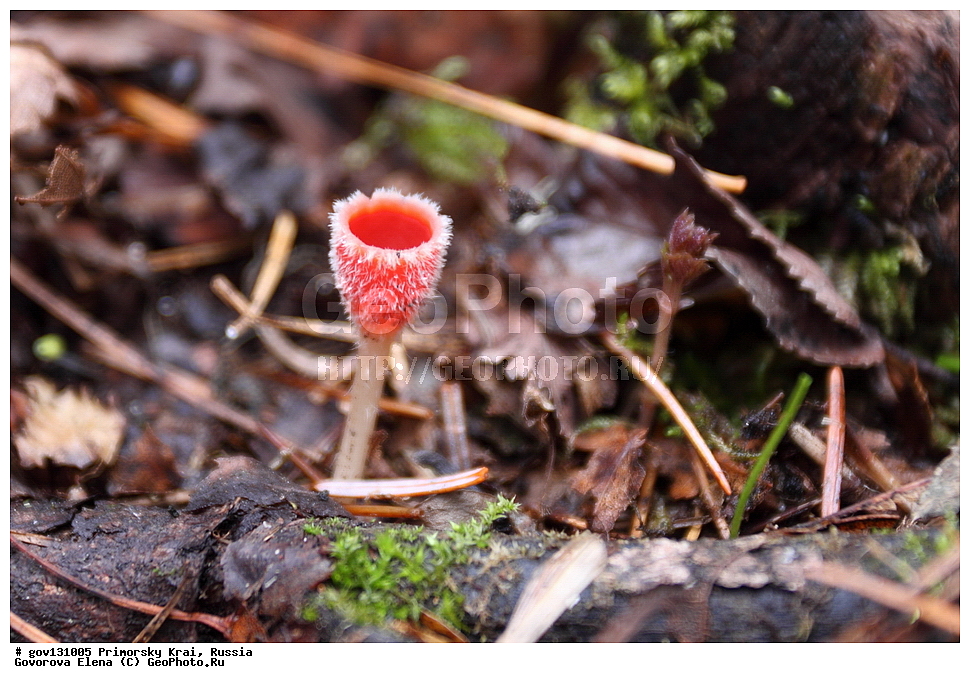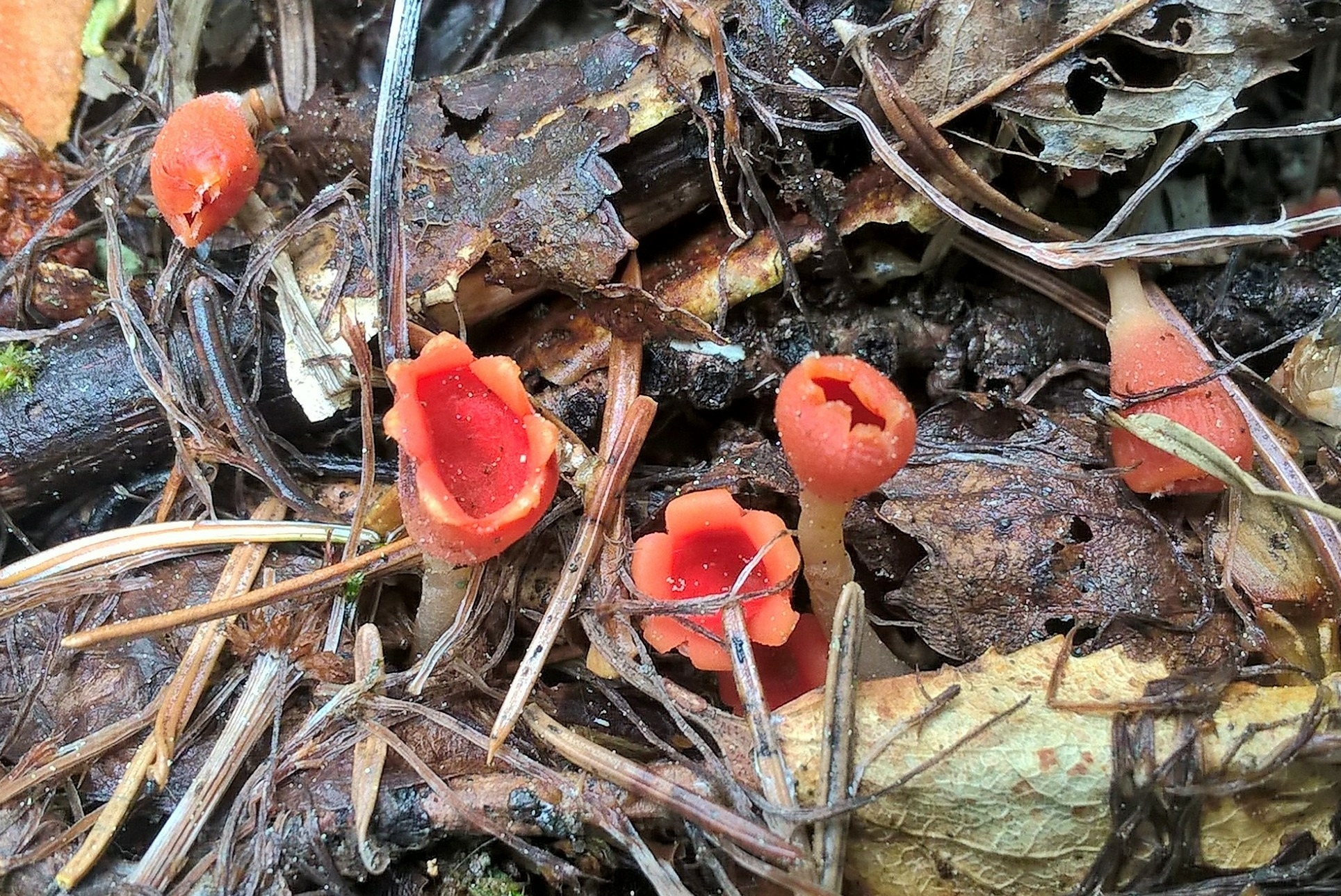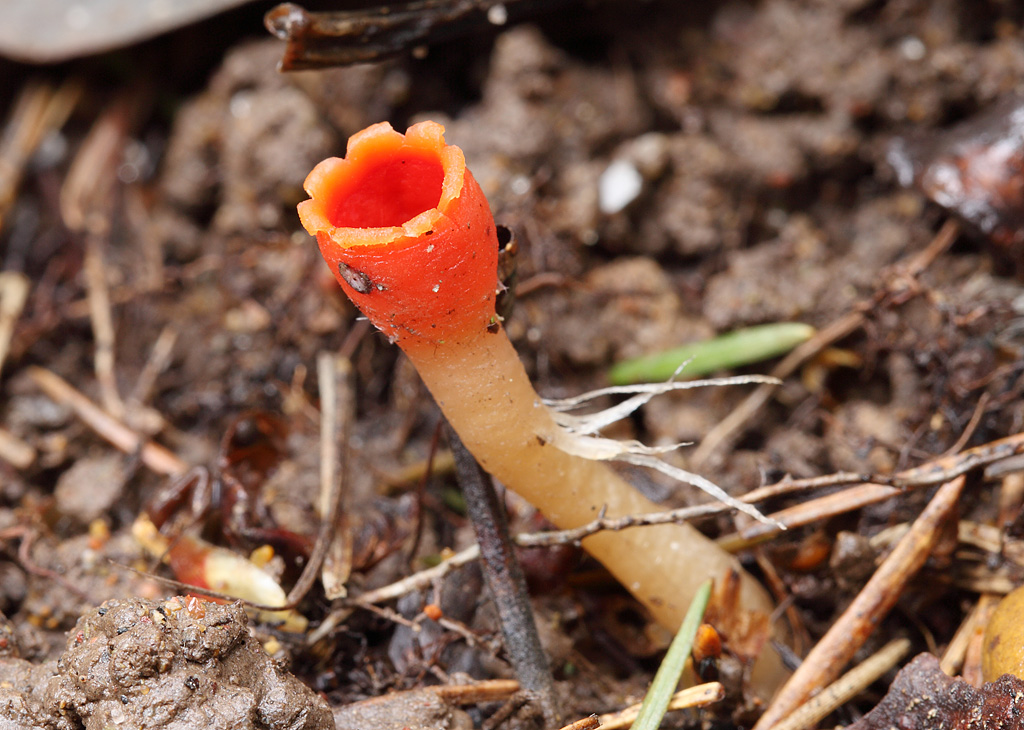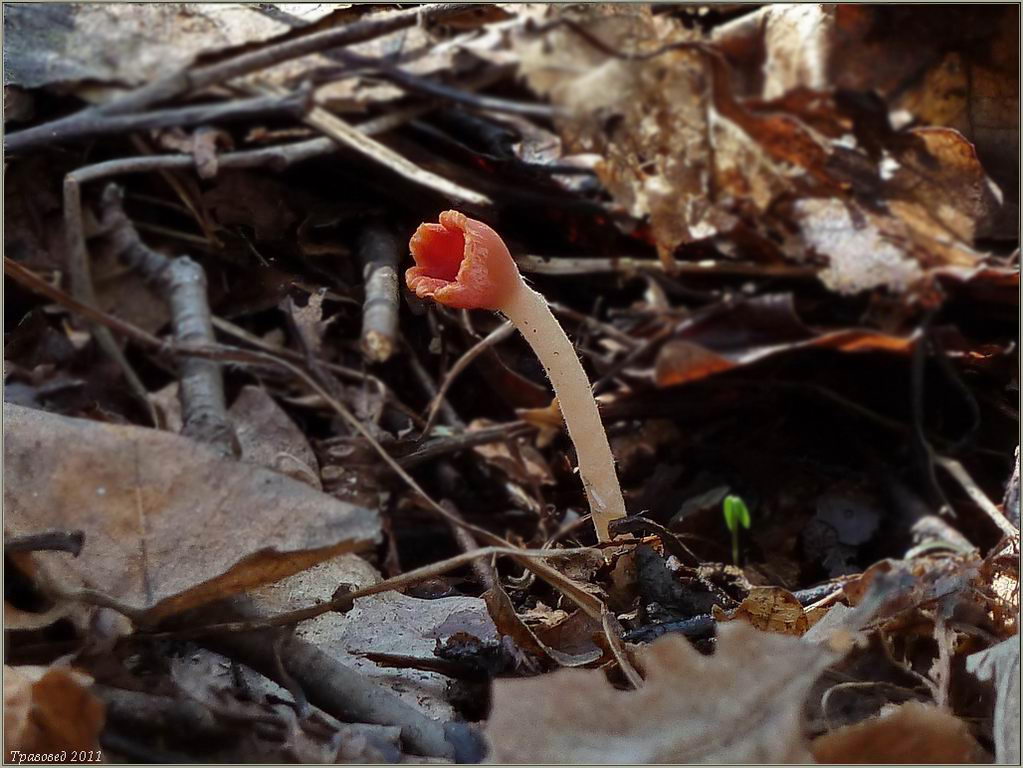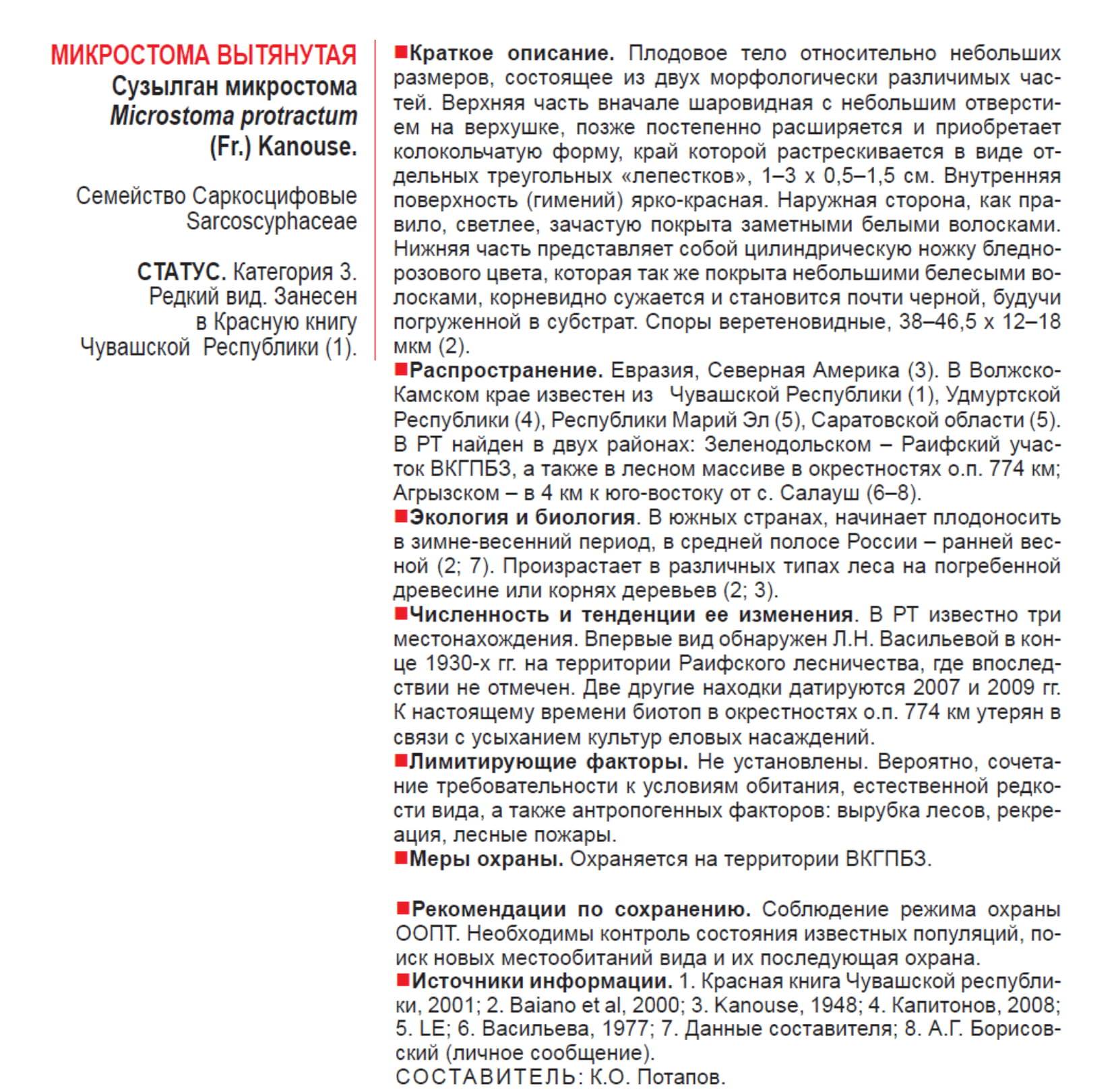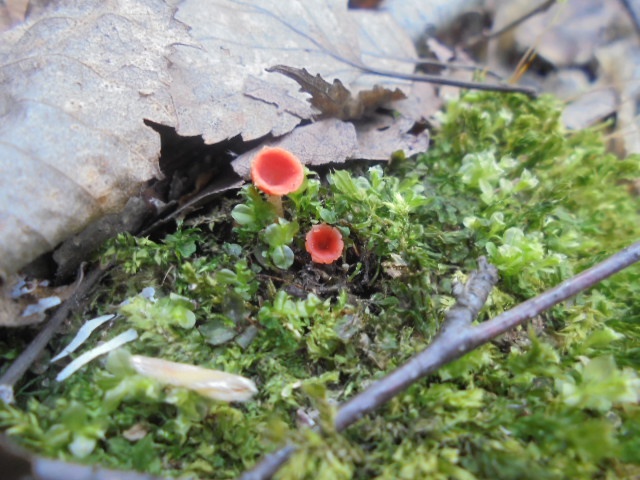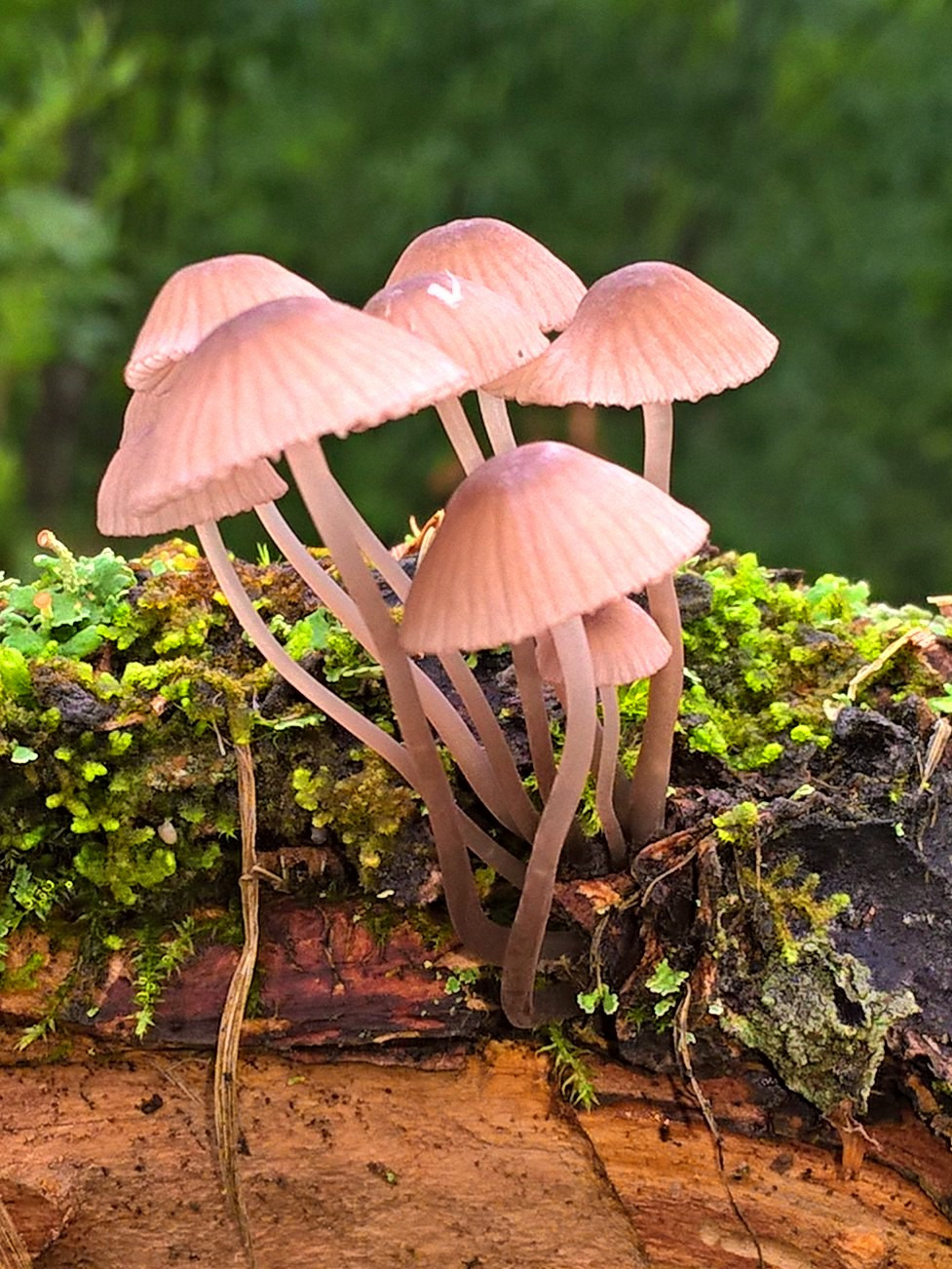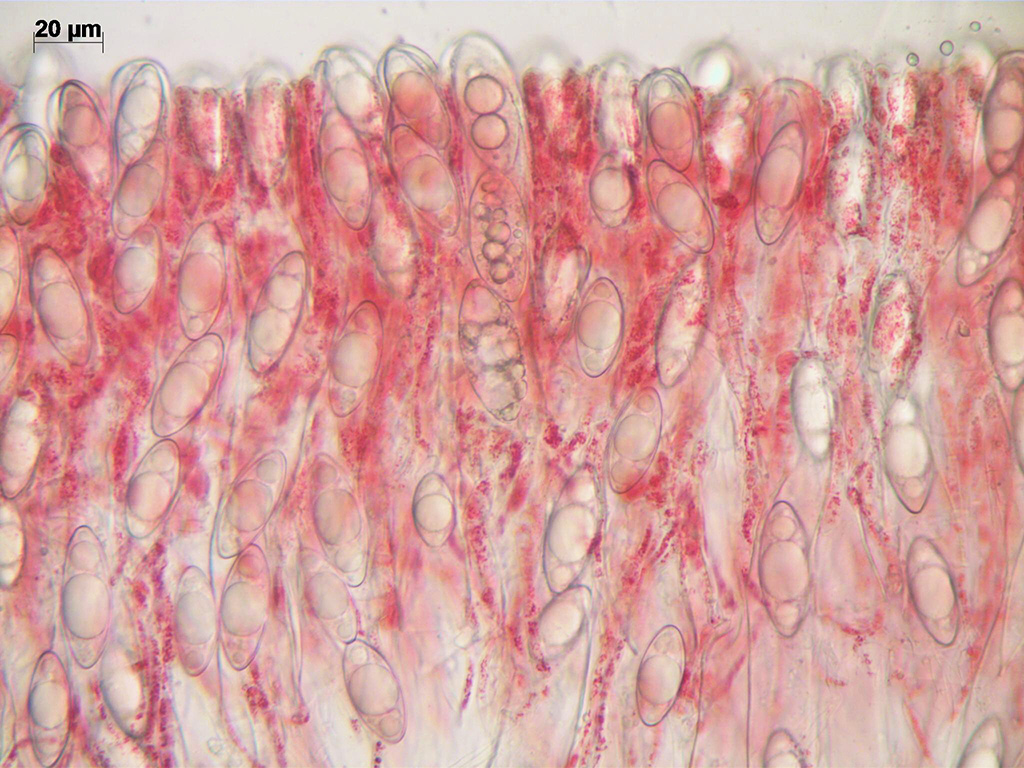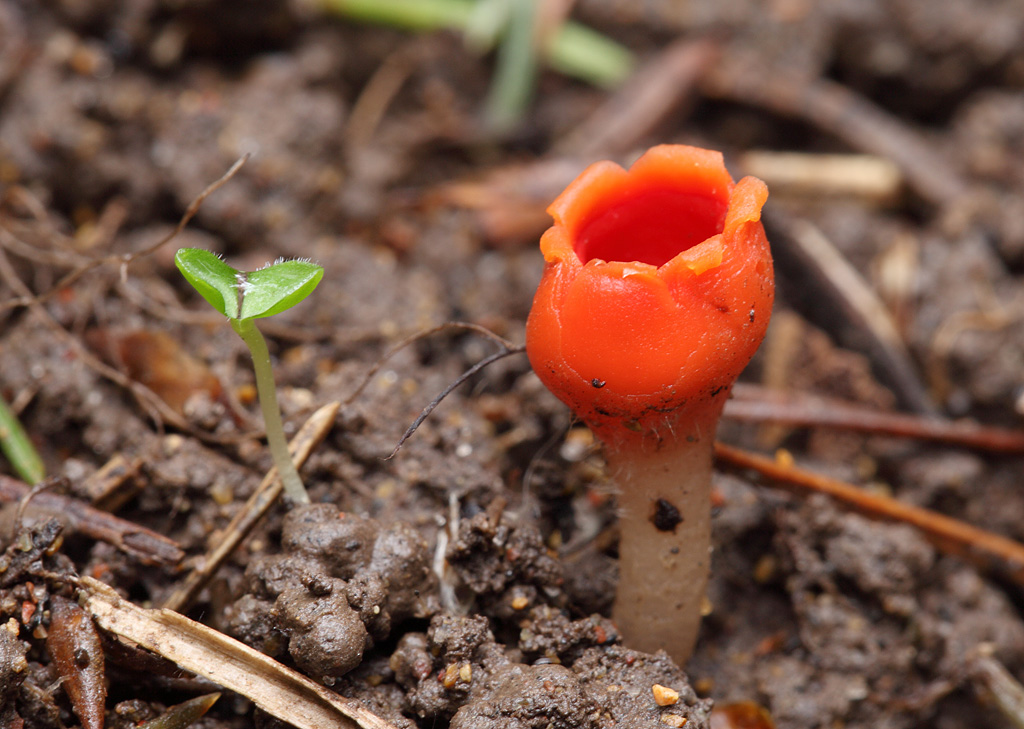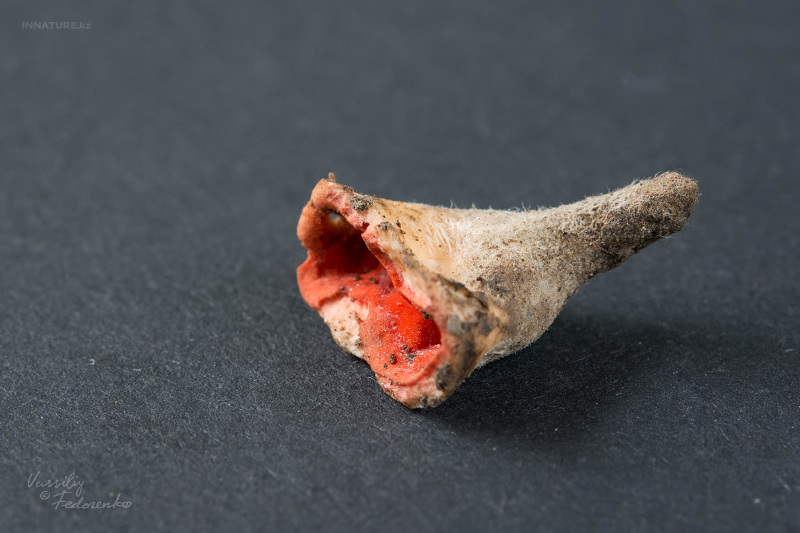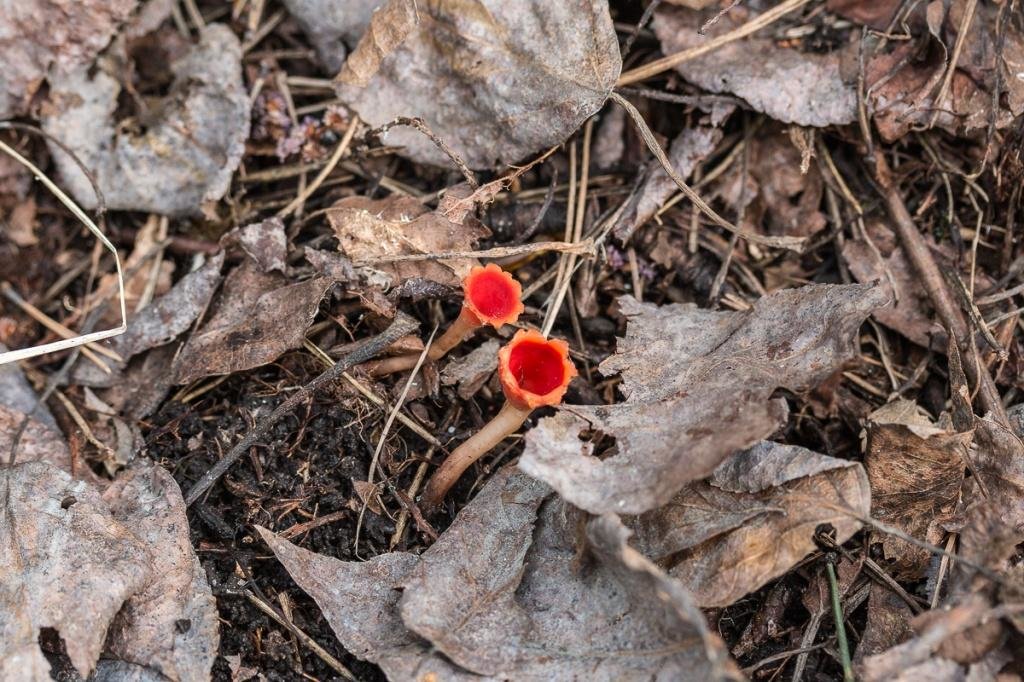Synonyms
- Anthopeziza baccata (Fuckel) Wettst., 1885
- Anthopeziza protracta (Fr.) Nannf., 1949
- Anthopeziza winteri Wettst., 1885
- Lachnea mirabilis (I.G. Borshch.) W. Phillips, 1890
- Microstoma hiemale Bernstein, 1852typus
- Peziza mirabilis I. G. Borshch., 1857
- Peziza protracta Fr., 1851basionym
- Plectania hiemalis (Bernstein) Seaver, 1928
- Plectania protracta (Fr.) S. Imai, 1938
- Plectania subfloccosa Hazsl., 1885
- Sarcoscypha hiemalis (Bernstein) J. Schröt., 1893
- Sarcoscypha protracta (Fr.) Sacc., 1889
- Sclerotinia baccata Fuckel, 1870
- Sclerotinia hiemalis (Bernstein) Fuckel, 1873
- Scypharia hiemalis (Bernstein) Quél., 1886
Synonyms
- Anthopeziza baccata (Fuckel) Wettst., 1885
- Anthopeziza protracta (Fr.) Nannf., 1949
- Anthopeziza winteri Wettst., 1885
- Lachnea mirabilis (I.G. Borshch.) W. Phillips, 1890
- Microstoma hiemale Bernstein, 1852typus
- Peziza mirabilis I. G. Borshch., 1857
- Peziza protracta Fr., 1851basionym
- Plectania hiemalis (Bernstein) Seaver, 1928
- Plectania protracta (Fr.) S. Imai, 1938
- Plectania subfloccosa Hazsl., 1885
- Sarcoscypha hiemalis (Bernstein) J. Schröt., 1893
- Sarcoscypha protracta (Fr.) Sacc., 1889
- Sclerotinia baccata Fuckel, 1870
- Sclerotinia hiemalis (Bernstein) Fuckel, 1873
- Scypharia hiemalis (Bernstein) Quél., 1886
Synonyms
- Anthopeziza baccata (Fuckel) Wettst., 1885
- Anthopeziza protracta (Fr.) Nannf., 1949
- Anthopeziza winteri Wettst., 1885
- Lachnea mirabilis (I.G. Borshch.) W. Phillips, 1890
- Microstoma hiemale Bernstein, 1852typus
- Peziza mirabilis I. G. Borshch., 1857
- Peziza protracta Fr., 1851basionym
- Plectania hiemalis (Bernstein) Seaver, 1928
- Plectania protracta (Fr.) S. Imai, 1938
- Plectania subfloccosa Hazsl., 1885
- Sarcoscypha hiemalis (Bernstein) J. Schröt., 1893
- Sarcoscypha protracta (Fr.) Sacc., 1889
- Sclerotinia baccata Fuckel, 1870
- Sclerotinia hiemalis (Bernstein) Fuckel, 1873
- Scypharia hiemalis (Bernstein) Quél., 1886
Elongated microstoma (Microstoma protractum)

The elongated microstomy is one of those mushrooms, with the definition of which it is impossible to be mistaken. There is only one small problem: to find this beauty, you have to move through the forest literally on all fours.
Description
The shape of a mushroom is most similar to a flower. Apothecia develops on a whitish stem, at first spherical, then elongated, ovoid, red, with a small hole at the top, and it looks so much like a flower bud! Then this "bud" bursts, turning into a goblet "flower" with a well-defined jagged edge.
The outer surface of the "flower" is covered with the finest translucent whitish hairs, the thickest at the border of the leg and apothecia. The inner surface is bright red, scarlet, smooth. With age, the blades of the "flower" open more and more, acquiring not a goblet, but a saucer-like shape.
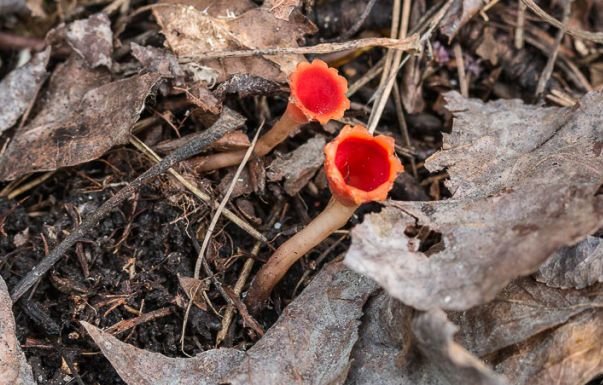
Sizes: "Cup" diameter up to 2.5 cm
Leg height up to 4 cm, leg thickness up to 5 mm
Season: Different sources indicate slightly different times (for the northern hemisphere). April - first half of June; spring - early summer; there is a mention that the mushroom can be found in the very early spring, literally at the first melting of the snow. But all sources agree on one thing: it is a fairly early mushroom.

Ecology: It grows on branches of coniferous and deciduous species submerged in the soil. It occurs in small groups in coniferous and mixed, less often in deciduous forests throughout the European part, beyond the Urals, in Siberia.
Edible: No data available.
Similar species: Microstoma floccosum, but much more furry. Sarcoscypha occidentalis is also small and red, but it has a completely different shape, not goblet, but cupped.
Synonyms [| code]
- Anthopeziza baccata (Fuckel) Wettst., 1885
- Anthopeziza protracta (Fr.) Nannf., 1949
- Anthopeziza winteri Wettst., 1885
- Lachnea mirabilis (I.G. Borshch.) W. Phillips, 1890
- Microstoma hiemale Bernstein, 1852typus
- Peziza mirabilis I. G. Borshch., 1857
- Peziza protracta Fr., 1851basionym
- Plectania hiemalis (Bernstein) Seaver, 1928
- Plectania protracta (Fr.) S. Imai, 1938
- Plectania subfloccosa Hazsl., 1885
- Sarcoscypha hiemalis (Bernstein) J. Schröt., 1893
- Sarcoscypha protracta (Fr.) Sacc., 1889
- Sclerotinia baccata Fuckel, 1870
- Sclerotinia hiemalis (Bernstein) Fuckel, 1873
- Scypharia hiemalis (Bernstein) Quél., 1886
Description
Fruiting bodies - located on a long sterile stem of an ovoid apothecia with a small rounded hole at the apex, in the process of growth, the edges of the hole break into 8-10 small lobes, by old age the apothecia fully open, acquiring a saucer-shaped shape, when open, 5-10 mm high and up to 2.5 cm in diameter. The outer surface of the fruiting body is pale reddish, with thick whitish hairs, most numerous at the border of the sterile stalk and the apothecia itself. The inner spore-bearing surface is bright scarlet, slightly fading with age. The leg is 1-4 (6) cm long and 2-3 (5) mm thick, whitish to pale pink in the upper part, brown in the lower part, long and thin, smoothly turning into spore-bearing apothecia, with a base deeply sinking into the ground, emerging from the black oblong sclerotia.
The pulp is whitish, strong, elastic.
Asci with 8 spores, 200-275 × 20-23 µm. The paraphysis is dichotomously branched, slightly widening at the end, slightly protruding above the asci. Spores are elliptical-fusiform, 25–45 (50) × 10–14 (16) µm, uncolored to pale yellowish, with one large and several small oil droplets, located in the asuka in one row.
ADDITIVE "ADDITIVE (Pseudotropheus)"
Rose: Rose: Perciformes Rose: Rose: Rose (Perciformes) Rose: Rose: Rose (Perciformes) Rose: Rose: Rose
Ll ° lokl ÑÑÑ lll +. ÐÐ ° Ð Ð ° Ð °Ð. Plug in and out.
Hearty, hearty, hearty, hearty ±. Grunt. Lol, lol, lol, lol, lol, l. Confused linen.
Soon and so on and on and on and on. Rose, Rose, Rose, Rose, Rose, Rose, Rose, Rose, Rose, Rose, Rose, Rose, Rose, Rose, Rose, Rose, Rose, Rose, Rose. Rose, Rose, Rose, Rose, Rose, Rose, Rose, Rose, Rose, Rose, Rose ÑÐ ”овÑÑ Ð¾Ð ·. ÐÐ ° Ð Ð ° Ð °Ð. Bottom line Bottom line Bottom line L »¾¾l ±. Bumpy bark Well, well, good, good, good, good, good. Donut Contact.
Rose: 24-28 °, d 4-20 °, 7.2-8.5 °, Rose, dull, dull. Burgundy, bark and bark, bark, bush Burgundy borealis °.
Rose: Rose (Rose 60%), Rose, Rose.
Burgundy, burgundy, birch, birch, burgundy ... Donut. Bump and bump.
Ð. Donut Power supply. Flare and flare. Ð. ÐÑÑÐ »ÑмР° ÐμÑ ÑÐμкомÐμнÐ'ÑÐμÑ Ð · Ð ° нÐμÑкол Ñко Ð'нÐμй Ð'о вÑÑоÐ'Ð ° мР° Ð »Ñков вÑл овиÑÑ ÑÐ ° Ð¼ÐºÑ Ð¸ пÐμÑÐμнÐμÑÑи в инкÑÐ ± Ð Donkey, donut, donut, donut, donut, donut, donut, donut, donut 17-24 hours.
Pointer: Pointer (Pointer Pointer).
оÐÐвР° Ð · ÐеРРв 8-12 Ðе.
Good morning:
- Pseudotropheus zebra
- Rosewood (Pseudotropheus livingstonii)
- Lambardoi (Pseudotropheus lombardoi)
- Pseudotropheus spec. P6)
- Pseudotropheus tropheops
Synonyms
- Anthopeziza baccata (Fuckel) Wettst., 1885
- Anthopeziza protracta (Fr.) Nannf., 1949
- Anthopeziza winteri Wettst., 1885
- Lachnea mirabilis (I.G. Borshch.) W. Phillips, 1890
- Microstoma hiemale Bernstein, 1852typus
- Peziza mirabilis I. G. Borshch., 1857
- Peziza protracta Fr., 1851basionym
- Plectania hiemalis (Bernstein) Seaver, 1928
- Plectania protracta (Fr.) S. Imai, 1938
- Plectania subfloccosa Hazsl., 1885
- Sarcoscypha hiemalis (Bernstein) J. Schröt., 1893
- Sarcoscypha protracta (Fr.) Sacc., 1889
- Sclerotinia baccata Fuckel, 1870
- Sclerotinia hiemalis (Bernstein) Fuckel, 1873
- Scypharia hiemalis (Bernstein) Quél., 1886
Donut: donut: donut.
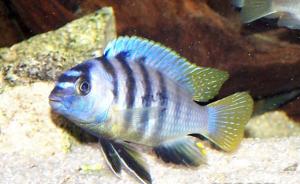
Reference: Pseudotropheus microstoma Trewavas, 1935
Rose 10 cm.
Bump, bump, bump, bump, bump, bump Rosewood. ¢ Bustle, bustle, bustle and bustle. Wedge, wedge, 6-8 wedge, wedge, wedge. Heart, heart, heart, heart, heart, heart Burgundy and burgundy °, good morning Donkey and donut.
Synonyms
- Anthopeziza baccata (Fuckel) Wettst., 1885
- Anthopeziza protracta (Fr.) Nannf., 1949
- Anthopeziza winteri Wettst., 1885
- Lachnea mirabilis (I.G. Borshch.) W. Phillips, 1890
- Microstoma hiemale Bernstein, 1852typus
- Peziza mirabilis I. G. Borshch., 1857
- Peziza protracta Fr., 1851basionym
- Plectania hiemalis (Bernstein) Seaver, 1928
- Plectania protracta (Fr.) S. Imai, 1938
- Plectania subfloccosa Hazsl., 1885
- Sarcoscypha hiemalis (Bernstein) J. Schröt., 1893
- Sarcoscypha protracta (Fr.) Sacc., 1889
- Sclerotinia baccata Fuckel, 1870
- Sclerotinia hiemalis (Bernstein) Fuckel, 1873
- Scypharia hiemalis (Bernstein) Quél., 1886
Microstomy causes

The word mikrostomiya translated from Greek sounds like mikro - micro, stoma - mouth. Microstomy is a scar formation on the mucous membrane that affects the soft tissues in the cheek area, which causes the mouth to "tighten".
Congenital anomaly is extremely rare and is associated with impaired intrauterine development of the fetus. Most often, patients look in medical dictionaries for the concept of acquired pathology and information on the treatment of microstomy.
There are several reasons for the onset of the disease:
- injury to the near-mouth areas;
- surgery for tumor removal or osteomyelitis;
- burns to the front of the head;
- purulent inflammatory and ulcerative processes;
- burns;
- plastic surgery.
As a result of a decrease in the opening of the mouth, a person suffers not only from a cosmetic defect, his speech is impaired, and food intake is difficult. Kelloids lead to a change in the dentition.
With the development of the disease at an early age, deformation of the dentition is observed. Healed tissues sometimes cause mental disorders and depressive states of the patient. It is often difficult for a doctor to establish contact with a person.
Synonyms
- Anthopeziza baccata (Fuckel) Wettst., 1885
- Anthopeziza protracta (Fr.) Nannf., 1949
- Anthopeziza winteri Wettst., 1885
- Lachnea mirabilis (I.G. Borshch.) W. Phillips, 1890
- Microstoma hiemale Bernstein, 1852typus
- Peziza mirabilis I. G. Borshch., 1857
- Peziza protracta Fr., 1851basionym
- Plectania hiemalis (Bernstein) Seaver, 1928
- Plectania protracta (Fr.) S. Imai, 1938
- Plectania subfloccosa Hazsl., 1885
- Sarcoscypha hiemalis (Bernstein) J. Schröt., 1893
- Sarcoscypha protracta (Fr.) Sacc., 1889
- Sclerotinia baccata Fuckel, 1870
- Sclerotinia hiemalis (Bernstein) Fuckel, 1873
- Scypharia hiemalis (Bernstein) Quél., 1886
Principles and features of microstomy treatment
The methods of treating the disease consist in surgical intervention, but it is not always possible to solve the problem by surgery.
In the treatment of microstomy, much attention is paid to the state of the oral cavity, since tissue infection is the reason for the aggravation of the scar process. Before the operation, the dentist examines, removes plaque and treats caries
Surgical intervention
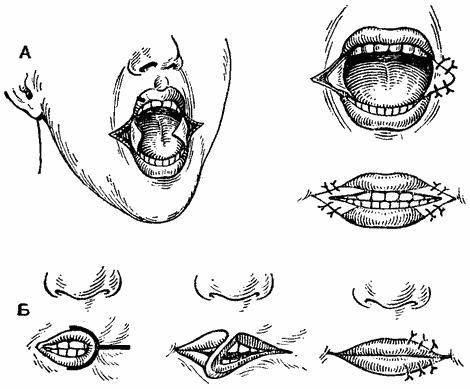
In most cases, the procedure is indicated for patients with burns, ulcerative and necrotic processes. The stages of surgery in the treatment of microstomy are as follows:
- Anesthesia with infiltration pain relievers.
- Dissection of adhesions, dense keloids.
- Dilution of the gap of the mouth in the area of the corners to a normal state. Incisions are made through the skin and muscle layer. Their distance is up to one and a half centimeters.
- A skin fragment is formed in the cheek area in the form of a swallow's tail.
- Two more similar flaps are formed for the upper and lower lip.
- The mucous membrane is turned inside out and attached to the edges of the dissected integuments.
- To create a border with a red tint, a hemmed sheath is applied so that it overlaps the edge of the wound surface.
Another plastic correction technique has been described by physician Limberg. The specialist notes that in the corner areas of the mouth it is necessary to combine lateral incisions with the imposition of flaps connected at the ends.
But the engraftment of fragments sometimes causes a necrotic process and a relapse of deformity, so the technique is not applicable for defects with gross hypertrophic scars.
Contraindications to the operation
The doctor takes into account the following factors affecting the possibility of plastic surgery:
- mature or too young age of the patient;
- general condition of the body;
- scleroderma;
- tuberculous lupus.
Operations are not performed for a number of serious diseases. One of these pathologies is bone marrow damage. In acute leukemia, more immature cells are found in the blood: monoblasts, which are the ancestors of monocytes. They differentiate into promonocytes - these are cells of the monocytic series, which are further transformed into a macrophage. In pathology, cells with malignant nuclei cause an increase in lymph nodes and a change in the composition of the blood, which makes surgical intervention impossible.
Prosthetic techniques for microstomy treatment
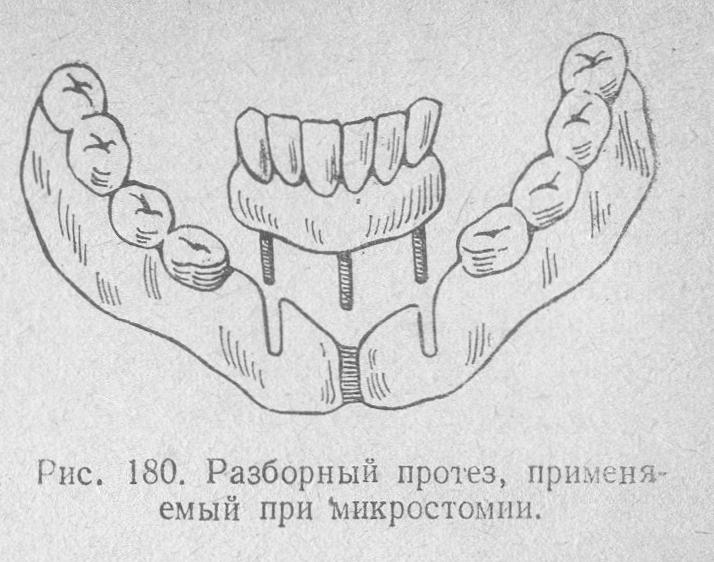
As a result of deformation of the mouth opening, the narrowing reaches up to 3 cm. This leads to a loss of elasticity and tightness by large keloids. In such situations, plastic correction is not advisable.Surgery causes scar recurrence.
Standard prosthetics are also ineffective and difficult in the following cases:
- defects of alveolar sprouts;
- spread of scars to the mucous membrane of the prosthetic field;
- secondary curvature of the dentition.
Also, the difficulties of prosthetics are associated with the problems of forming an impression for the manufacture of a structure.
Instead of ordinary spoons, the doctor uses special collapsible ones or cuts a standard instrument into two halves.
The procedure for taking an impression is as follows:
- One part of the spoon with plaster material is introduced into the area of the left or right jaw.
- After hardening, the instrument is separated and taken out, a new layer is applied to the front edge of the impression.
- The second half of the spoon with plaster is introduced for the other jaw, similar manipulations are carried out.
- After hardening, the material is cut in the usual way, removed from the mouth.
- Connect both halves and cast the model.
To determine the central articulation with the participation of the muscles that control the lower jaw, not ordinary wax templates are used, since they are deformed, but silicone rollers. After that, the doctor determines the model of the prosthesis.
Orthopedic structures in the treatment of microstomy

The choice of the type of prosthesis depends on a number of factors:
- the size of cicatricial formations and their density;
- the level of changes in the soft tissues of the face and mouth;
- the condition of the dentition;
- the nature of the damage.
There are two types of prostheses:
- The folding fixing device consists of two parts, which are connected by means of a hinge and a front element. For installation, it is inserted into the oral cavity, pushed apart and fixed on the jaw.
- Dismountable prosthetic models consist of several separate parts. They are inserted and secured with tubes and pins. In the manufacture, a telescopic mounting system is used, as it is more reliable.
One of the important conditions for the successful treatment of microstomy is the choice of the model of the supporting structure. It should be removable or combined, not to complicate the patient's hygiene measures. The prosthesis should be well fixed in order to prevent contraction of the scar zones, but there is no intermaxillary attachment in order to prevent joint contracture.

Synonyms [| code]
- Anthopeziza baccata (Fuckel) Wettst., 1885
- Anthopeziza protracta (Fr.) Nannf., 1949
- Anthopeziza winteri Wettst., 1885
- Lachnea mirabilis (I.G. Borshch.) W. Phillips, 1890
- Microstoma hiemale Bernstein, 1852typus
- Peziza mirabilis I. G. Borshch., 1857
- Peziza protracta Fr., 1851basionym
- Plectania hiemalis (Bernstein) Seaver, 1928
- Plectania protracta (Fr.) S. Imai, 1938
- Plectania subfloccosa Hazsl., 1885
- Sarcoscypha hiemalis (Bernstein) J. Schröt., 1893
- Sarcoscypha protracta (Fr.) Sacc., 1889
- Sclerotinia baccata Fuckel, 1870
- Sclerotinia hiemalis (Bernstein) Fuckel, 1873
- Scypharia hiemalis (Bernstein) Quél., 1886

